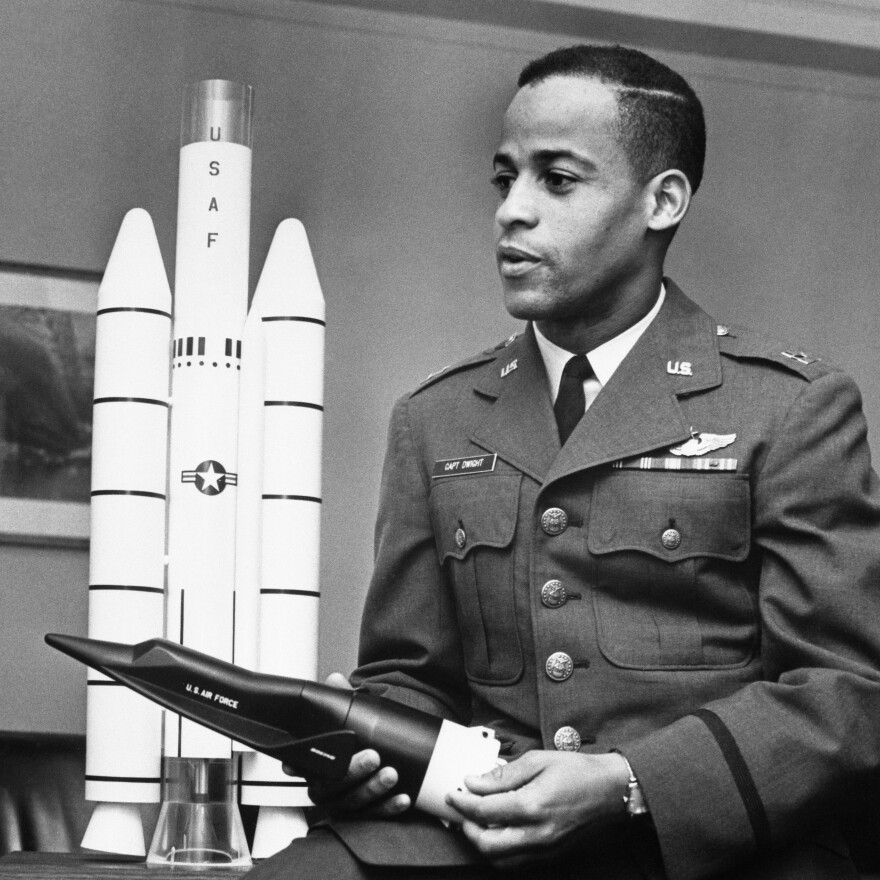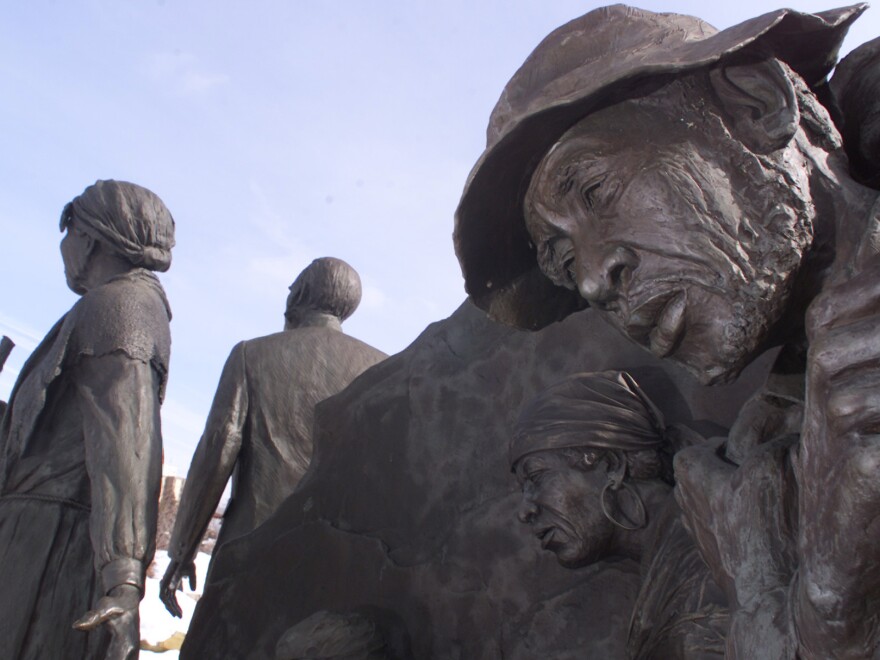Edward J. Dwight Jr. has waited a long time for his ride into space.
In the 1960s, he seemed poised to become America's first Black astronaut. That dream was never realized. Now, at age 90, he's about to finally get his shot, aboard a Blue Origin rocket.
The opportunity is "a curiosity more than anything else," Dwight says. "They called me up and asked me if I was interested. And of course I said yes."
While Dwight won't be the first African American in space — that honor went to Guion Bluford Jr. in 1983 — he will be the oldest person to go there, edging out (by a few months) Star Trek actor William Shatner, who flew aboard a Blue Origin rocket in 2021.
For many his age, a journey into space would seem unthinkable. Dwight says he's ready to go. He points out that the rigors of his upcoming flight won't be much different from what he experienced as a test pilot in the Air Force. "I've pulled more G's than any person on Earth," he says with a wry smile. "I've been high enough to see the curvature of the Earth. ... I've been doing things like that most of my life."
Space health expert Dorit Donoviel says the 11-minute flight of Blue Origin's New Shepard rocket means many of the concerns about the long-term effects of orbital and deep-space missions won't come into play.
"The main thing we worry about is the G forces," says Donoviel, director of the Translational Research Institute for Space Health at Baylor College of Medicine.

Those G forces cause blood to drain from the head, and that's an issue for anyone launching into space, regardless of age. However, she points out that the seats aboard Blue Origin's rocket are angled at 20 or 30 degrees. "As you're experiencing the G-forces, you're getting it through the chest, which is not affecting your head," Donoviel says. "It's distributed through the chest, which really shouldn't matter very much."
And then there's the landing. The crew capsule will separate from the booster and come down under a set of parachutes — emitting a last-minute retro thrust to reduce speed to about 2 miles per hour to cushion the impact. "It's not even a controlled crash. It's a crash," Donoviel says. Still, she anticipates no issues.
No launch date set
Blue Origin has not announced a launch date yet. But Dwight and his crewmates will train for two days before liftoff at the company's Launch Site One in western Texas, not far from the Mexico border.
The company, owned by billionaire Jeff Bezos, declined to disclose the per-passenger cost of the flight, but says Dwight's seat is being sponsored by Space for Humanity and Blue Origin, with additional support from the Jaison and Jamie Robinson Family Foundation. (Jaison Robinson, who flew on a previous Blue Origin flight, is on the NPR Foundation Board of Trustees.)
Leland Melvin, a retired NASA astronaut who flew two space shuttle missions to the International Space Station, says it will be good to see Dwight finally "get his due" all these years after he first trained for space.
Dwight sees his upcoming spaceflight as the "climax to an interesting story."
His own story, that is. One of the earliest chapters begins at an airfield in Kansas City, Kan. As a child, Dwight's fascination with aviation led to odd jobs cleaning aircraft owned by wealthy flyers. But even then, he had greater ambitions. "I told them I didn't want their nickels and dimes for cleaning airplanes anymore," he says. "I wanted to fly." At age 8, he got his first flight.
Dwight was equally interested in art and earned a scholarship to pursue his passion after high school. His father would have none of it. Art wasn't a real career, he insisted. Dwight should study engineering instead, so he enrolled at a junior college, receiving an associate's degree in 1953, the same year he enlisted in the Air Force.
After finishing primary flight training, he was commissioned as a second lieutenant. Dwight also got a bachelor's of science in aeronautical engineering from Arizona State University. Discrimination was an ever-present reality in the armed forces at the time, but as a skilled pilot, he made captain.
Kennedy wanted a Black astronaut
That's when President John F. Kennedy — eager to link his administration's push for civil rights to the country's early space exploration efforts — asked for a Black astronaut.
At the time, it was test pilots who became astronauts, and there were no Black test pilots. So, Dwight was invited to attend the Air Force's newly opened Aerospace Research Pilot School (ARPS).
But when he got the invitation letter, he almost threw it out, Dwight recalls. His Air Force peers "got a big laugh out of it," telling him that "all those guys have swagger, and it's a club," he said, referring to the all-white astronaut corps. They said, "They are not going to let you get in that club."
"And, of course, they were right," he says.
It was a huge career gamble. Dwight's father, who played baseball in the Negro Leagues, was strongly opposed. His mother, though, changed her son's mind. "She said, 'You are going to do this' because she was thinking it would be uplifting the race and racial pride," he says.
Upon entering the flight-test program, Dwight experienced immediate pushback that he says was rooted in racism. He says Chuck Yeager, the famed test pilot who ran the school, resented having to accept a Black candidate. (Yeager, who died in 2020, wrote in his memoir that his only issue was Dwight's piloting skills, which he described as "average.")
Once on the astronaut track, Dwight became a minor celebrity, especially in the Black community. He appeared on the cover of magazines such as Ebony and Jet. But he also endured taunts of "Kennedy's boy" because of the president's support.
Kennedy's 1963 assassination nearly derailed Dwight's training, he says. Days after the president's death, "Lo and behold, I had orders in my mailbox shipping me out of the country," he says.
Attorney General Robert F. Kennedy, the president's brother, intervened to keep him in the program, according to Dwight. He stayed in the Air Force for a few more years, but it became increasingly clear that he would not be selected as an astronaut. "When I found out it wasn't going to happen, that's when I left the program," he says. "I just packed my bags and left."

After the Air Force, Dwight, who eventually settled in Denver, became a computer systems engineer for IBM, later opened a restaurant and worked as a real estate developer before being drawn back to his childhood love of art. Despite having little formal training, he was commissioned in 1974 to create a sculpture of Colorado's first Black lieutenant governor, George Brown.
From would-be astronaut to sculptor
From there, his reputation as a sculptor blossomed. In 1977, he earned a master's of fine art in sculpture from the University of Denver. He specializes in sculpting historic African American figures. Among his more notable pieces are busts of jazz greats Dizzy Gillespie and one of Louis Armstrongon display at the National Museum of American History.
Melvin, who is African American, says when he met Dwight, he didn't know much about his backstory. "I got a copy of his book and I read some of the stuff that he had done," he says. "He reminded me of Katherine Johnson," the NASA mathematician who led an all-woman group of "computers," who made vital orbital calculations for the agency's early crewed spaceflights. Their story was later featured in Hidden Figures, the book and 2016 film.
Dwight and Melvin became close friends. In recent months, they have worked together on The Space Race, a documentary released last year about the contributions and experiences of Black astronauts. Dwight's own story is prominent in the film.
"He's not only funny, he's self-deprecating," Melvin says of Dwight. And one quality stands out. "He's got grit."
"But the other thing that his mother taught him was grace," he says. So, when being an astronaut didn't work all those years ago, "he gracefully pivoted to doing something else. It was just as impactful — just as impactful, especially in the Black community, which was his sculpture."
"He will now get his chance to do some zero-G floating and look at the planet from another vantage point," Melvin says.
Copyright 2024 NPR. To see more, visit https://www.npr.org.

